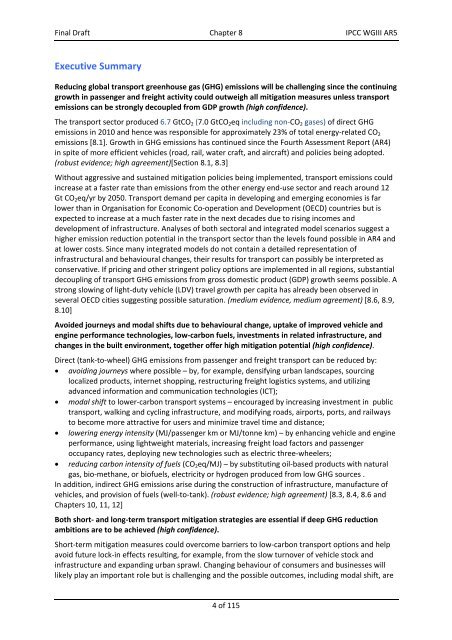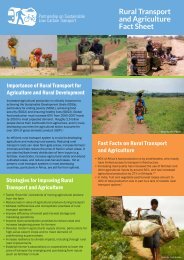ipcc_wg3_ar5_final-draft_postplenary_chapter8
ipcc_wg3_ar5_final-draft_postplenary_chapter8
ipcc_wg3_ar5_final-draft_postplenary_chapter8
Create successful ePaper yourself
Turn your PDF publications into a flip-book with our unique Google optimized e-Paper software.
Final Draft Chapter 8 IPCC WGIII AR5<br />
Executive Summary<br />
Reducing global transport greenhouse gas (GHG) emissions will be challenging since the continuing<br />
growth in passenger and freight activity could outweigh all mitigation measures unless transport<br />
emissions can be strongly decoupled from GDP growth (high confidence).<br />
The transport sector produced 6.7 GtCO 2 (7.0 GtCO 2 eq including non‐CO 2 gases) of direct GHG<br />
emissions in 2010 and hence was responsible for approximately 23% of total energy‐related CO 2<br />
emissions [8.1]. Growth in GHG emissions has continued since the Fourth Assessment Report (AR4)<br />
in spite of more efficient vehicles (road, rail, water craft, and aircraft) and policies being adopted.<br />
(robust evidence; high agreement)[Section 8.1, 8.3]<br />
Without aggressive and sustained mitigation policies being implemented, transport emissions could<br />
increase at a faster rate than emissions from the other energy end‐use sector and reach around 12<br />
Gt CO 2 eq/yr by 2050. Transport demand per capita in developing and emerging economies is far<br />
lower than in Organisation for Economic Co‐operation and Development (OECD) countries but is<br />
expected to increase at a much faster rate in the next decades due to rising incomes and<br />
development of infrastructure. Analyses of both sectoral and integrated model scenarios suggest a<br />
higher emission reduction potential in the transport sector than the levels found possible in AR4 and<br />
at lower costs. Since many integrated models do not contain a detailed representation of<br />
infrastructural and behavioural changes, their results for transport can possibly be interpreted as<br />
conservative. If pricing and other stringent policy options are implemented in all regions, substantial<br />
decoupling of transport GHG emissions from gross domestic product (GDP) growth seems possible. A<br />
strong slowing of light‐duty vehicle (LDV) travel growth per capita has already been observed in<br />
several OECD cities suggesting possible saturation. (medium evidence, medium agreement) [8.6, 8.9,<br />
8.10]<br />
Avoided journeys and modal shifts due to behavioural change, uptake of improved vehicle and<br />
engine performance technologies, low‐carbon fuels, investments in related infrastructure, and<br />
changes in the built environment, together offer high mitigation potential (high confidence).<br />
Direct (tank‐to‐wheel) GHG emissions from passenger and freight transport can be reduced by:<br />
avoiding journeys where possible – by, for example, densifying urban landscapes, sourcing<br />
localized products, internet shopping, restructuring freight logistics systems, and utilizing<br />
advanced information and communication technologies (ICT);<br />
modal shift to lower‐carbon transport systems – encouraged by increasing investment in public<br />
transport, walking and cycling infrastructure, and modifying roads, airports, ports, and railways<br />
to become more attractive for users and minimize travel time and distance;<br />
lowering energy intensity (MJ/passenger km or MJ/tonne km) – by enhancing vehicle and engine<br />
performance, using lightweight materials, increasing freight load factors and passenger<br />
occupancy rates, deploying new technologies such as electric three‐wheelers;<br />
reducing carbon intensity of fuels (CO 2 eq/MJ) – by substituting oil‐based products with natural<br />
gas, bio‐methane, or biofuels, electricity or hydrogen produced from low GHG sources .<br />
In addition, indirect GHG emissions arise during the construction of infrastructure, manufacture of<br />
vehicles, and provision of fuels (well‐to‐tank). (robust evidence; high agreement) [8.3, 8.4, 8.6 and<br />
Chapters 10, 11, 12]<br />
Both short‐ and long‐term transport mitigation strategies are essential if deep GHG reduction<br />
ambitions are to be achieved (high confidence).<br />
Short‐term mitigation measures could overcome barriers to low‐carbon transport options and help<br />
avoid future lock‐in effects resulting, for example, from the slow turnover of vehicle stock and<br />
infrastructure and expanding urban sprawl. Changing behaviour of consumers and businesses will<br />
likely play an important role but is challenging and the possible outcomes, including modal shift, are<br />
4 of 115



